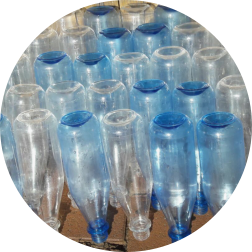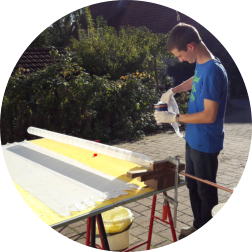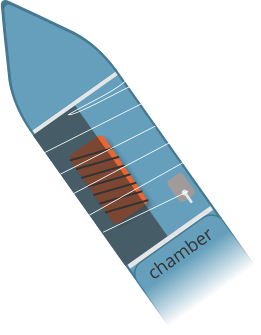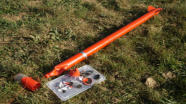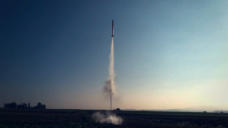FALCON
OUR LATEST WATER ROCKET GENERATION

After
gaining
a
lot
of
experience
with
our
Ueberflieger
Evo
and
Arrow
rockets
last
year,
we
have
noticed
that
the
difference
in
altitude
between
our
biggest
rockets
and
their
smaller
pendants
is
not
very
big.
At
the
same
time,
it
is
much
more
time
consuming
to
prepare
a
big
rocket
for
its
launch.
So,
the
DTMS
department
of
our
team
has
thought
about
ways
how
to
increase
both
altitude
and
efficiency
while
keeping
the
preparation
time
as
short
as
possible.
A
simple
way
to
do
that
would
be
to
increase
the
pressure
in
the
rocket
chamber,
but
it
is
very
difficult
and
quite
expensive
to
build
pressure
vessels
which
can
handle
such
high
pressure.
But
we
have
found
another
way:
We
reduced
the
drag
of
the
rocket
by
using
0.5
liter
bottles
from
Aloisius
Quelle
.
These
bottles
have
a
long
cylindrical
piece
and
have
no
patterns.
Therefore,
they
are
perfect
for
building
a
water
rocket
pressure
vessel.
The
bottle
sections
are
stuck
together
with
Sikaflex
11FC
.
All
Falcon
rocket
chambers
were
reinforced
with
two
layers
of
86g/m²
fiber
glass.
If
you
want
to
learn
more
about how we built the pressure vessels, check out
this tutorial
.
All
Falcon
rockets
have
a
single
large
vessel
,
because
that
helps
to
make
the
rocket
as
light
as
possible.
The
pressure
vessel
of
Falcon
1
has
bottle
threads
on
both
sides,
but
when
we
built
Falcon
2
and
Falcon
Mini
we
decided
to
use
a pressure vessel with only one bottle thread at the bottom.
THE IDEA
THE PRESSURE VESSEL



However,
with
the
decision
to
use
0,5L
bottles
for
the
rocket
we
were
concerned
that
the
rubber
band
of
a
typical
Phoenix
side
deployment
mechanism
could
no
longer
be
able
to
hold
the
parachute
door
in
place
due
to
the
high acceleration
at launch. So we decided to develop something new:
The
new
system
ejects
the
parachute
upwards
and
not
sidewards
like
the
Phoenix
system.
Of
course,
we
use
a
mechanical
tommy
timer
just
like
we
do
on
all
of
our
systems.
The
parachute
is
ejected
by
a
spring
made
of
a
plastic
bottle
piece
which
is
mounted
at
the
base
plate
of
the
system.
The
concept
shows
how
the
system
works.
We
used
this
system
in
Falcon
1
and
Falcon
2.
But
after
the
Falcon
1
crashed
for
unknown
reasons
we
decided
to
use
a
improved
version
of
the
Phoenix
system
on
the
rebuilt
version
of
the
rocket.
The
reason
for
that
decision
was
mainly
the
fact
that
it
was
quite
difficult
to
put
the nosecone onto the system.
THE PARACHUTE DEPLOYMENT SYSTEM
The
latest
generation
of
our
Phoenix
parachute
deployment
mechanism
is
basically
a
combination
of
our
existing
Phoenix
system
and
the
Radial
Deployment
System
which
was
invented
by
USWaterRockets.
We
have
already
used
a
improved
mechanical
version
of
the
RDS
in
many
water
rockets.
The
rubber
band
which
holds
the
parachute
door
in
place
is
now
wrapped
multiple
times
around
the
system
to
ensure
that
the
parachute
is
not
accidentally ejected.
CURRENT FALCON LINE-UP
FALCON LAUNCHES
Here is a video with the best launches of Falcon 1 and Falcon 2 as well as raw onboard footage from the Falcon Mini.
Click on the rockets to learn more about them.
12th May 2017
English



Change language:














After
gaining
a
lot
of
experience
with
our
Ueberflieger
Evo
and
Arrow
rockets
last
year,
we
have
noticed
that
the
difference
in
altitude
between
our
biggest
rockets
and
their
smaller
pendants
is
not
very
big.
At
the
same
time,
it
is
much
more
time
consuming
to
prepare
a
big
rocket
for
its
launch.
So,
the
DTMS
department
of
our
team
has
thought
about
ways
how
to
increase
both
altitude
and
efficiency
while
keeping
the
preparation
time
as
short
as
possible.
A
simple
way
to
do
that
would
be
to
increase
the
pressure
in
the
rocket
chamber,
but
it
is
very
difficult
and
quite
expensive
to
build
pressure
vessels
which
can
handle
such
high
pressure.
But
we
have
found
another
way:
We
reduced
the
drag
of
the
rocket
by
using 0.5 liter bottles from
Aloisius Quelle
.
These
bottles
have
a
long
cylindrical
piece
and
have
no
patterns.
Therefore,
they
are
perfect
for
building
a
water
rocket
pressure
vessel.
The
bottle
sections
are
stuck
together
with
Sikaflex
11FC
.
All
Falcon
rocket
chambers
were
reinforced
with
two
layers
of
86g/m²
fiber
glass.
If
you
want
to
learn
more
about
how
we
built
the
pressure
vessels,
check out
this tutorial
.
All
Falcon
rockets
have
a
single
large
vessel
,
because
that
helps
to
make
the
rocket
as
light
as
possible.
The
pressure
vessel
of
Falcon
1
has
bottle
threads
on
both
sides,
but
when
we
built
Falcon
2
and
Falcon
Mini
we
decided
to
use
a
pressure
vessel
with
only
one
bottle
thread
at
the
bottom.
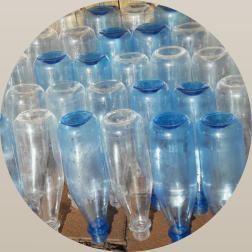
0.5 L bottles from Aloisius Quelle
THE IDEA
THE PRESSURE VESSEL
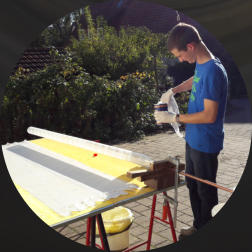
Reinforcing the pressure chamber of Falcon 2
However,
with
the
decision
to
use
0,5L
bottles
for
the
rocket
we
were
concerned
that
the
rubber
band
of
a
typical
Phoenix
side
deployment
mechanism
could
no
longer
be
able
to
hold
the
parachute
door
in
place
due
to
the
high
acceleration
at
launch.
So
we
decided
to
develop
something new:
The
new
system
ejects
the
parachute
upwards
and
not
sidewards
like
the
Phoenix
system.
Of
course,
we
use
a
mechanical
tommy
timer
just
like
we
do
on
all
of
our
systems.
The
parachute
is
ejected
by
a
spring
made
of
a
plastic
bottle
piece
which
is
mounted
at
the
base
plate
of
the
system.
The
concept
shows
how
the
system
works.
We
used
this
system
in
Falcon
1
and
Falcon
2.
But
after
the
Falcon
1
crashed
for
unknown
reasons
we
decided
to
use
a
improved
version
of
the
Phoenix
system
on
the
rebuilt
version
of
the
rocket.
The
reason
for
that
decision
was
mainly
the
fact
that
it
was
quite
difficult
to
put
the
nosecone
onto
the
system.
THE PARACHUTE SYSTEM
The
latest
generation
of
our
Phoenix
parachute
deployment
mechanism
is
basically
a
combination
of
our
existing
Phoenix
system
and
the
Radial
Deployment
System
which
was
invented
by
USWaterRockets.
We
have
already
used
a
improved
mechanical
version
of
the
RDS
in
many
water
rockets.
The
rubber
band
which
holds
the
parachute
door
in
place
is
now
wrapped
multiple
times
around
the
system
to
ensure
that
the
parachute is not accidentally ejected.
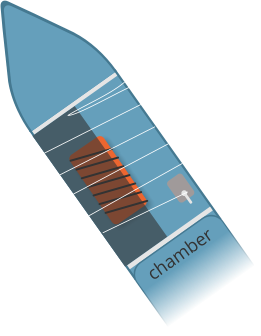
FALCON LAUNCHES
Here is a video with the best launches of Falcon 1
and Falcon 2 as well as raw onboard footage from
the Falcon Mini.
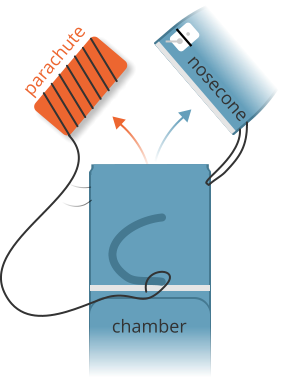
12th May 2017
FALCON
OUR LATEST WATER ROCKET GENERATION



CURRENT FALCON LINE-UP
Click on the rockets to learn more about them.








English



Change language:














HOME
ABOUT US
ROCKETS
LAUNCHES
ARTICLES
TUTORIALS
EDUCATION


HOME
ABOUT US
ROCKETS
LAUNCHES
ARTICLES
TUTORIALS
EDUCATION


